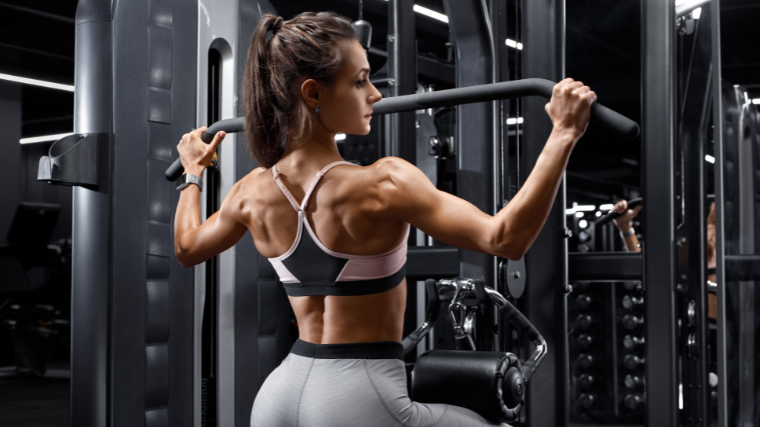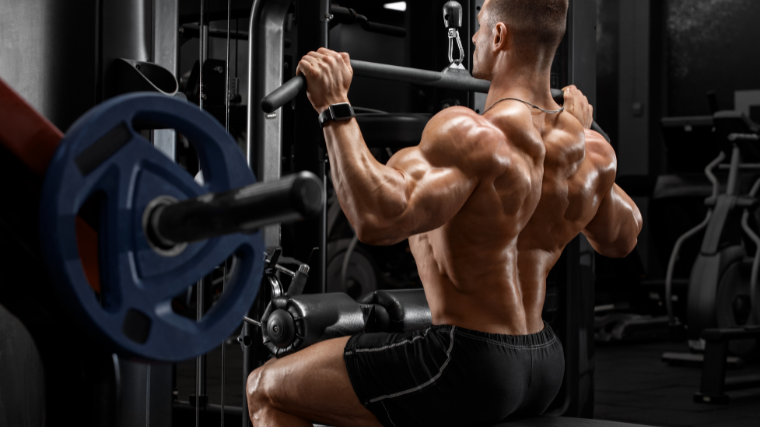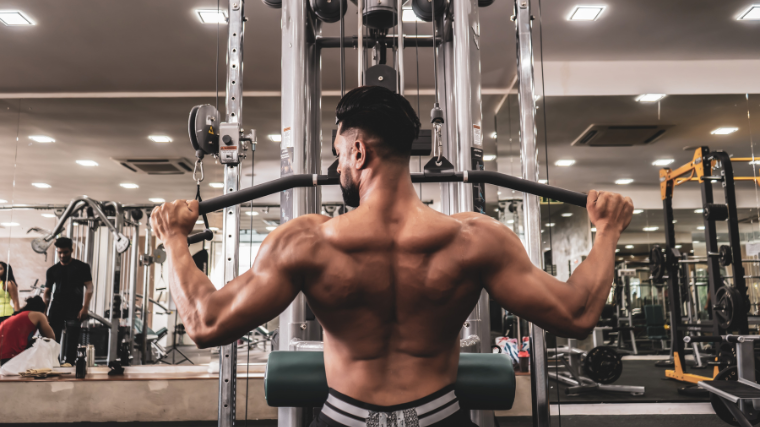There may be a buffet of back exercises out there to pick and choose from, but chances are you probably include the lat pulldown — or one of its many variations — into your training in some capacity
However, that doesn’t mean that the case is closed on the pulldown. There’s no question that it’s a phenomenal exercise to train your back, but what about how you perform it?

Bodybuilding lore dictates that you have to “go wide to get wide” and that a close-grip pulldown is better for upper back thickness. You might also be under the assumption that one form of pulldown is cheating.
Before you dive headfirst into your next back workout, you need to know the real difference — and what the science has to say — made by your grip in the lat pulldown.
Differences Between the Close-Grip and Wide-Grip Lat Pulldown
Even though these exercises are close cousins, there are still a few interesting differences between the close-grip and wide-grip pulldown. They may not necessarily affect how you train your back, but they’re worth pointing out.
Back Activation
While most pulldowns look more similar than different, that doesn’t mean they’re identical overall.
When equated for relative load as well as hand position (over vs underhand), a medium-width grip (as wide or slightly wider than your shoulders) tends to come out on top for lat engagement, with a double-shoulder-width grip falling a bit short. (1)
Loading Potential
Generally speaking, the more you widen your grip on a lat pulldown — whether with a pronated or supinated grip — the weaker you’ll get.
This isn’t directly due to lat activation per se, but it can be explained by looking at the mechanics of the movement. As you widen your grip, the attachment point of the lever (your hand) moves further out of vertical alignment from your shoulder.

Widening your grip will reduce your leverage, as the fibers of your lats are oriented more vertically than horizontally, and are thus better-suited to a vertical line of pull.
Using a lighter weight is also not synonymous with being “worse,” especially from a muscle growth standpoint. There’s no reason to throw wide-grip pulls in the wastebin if you want to grow your back.
Learning Curve
You shouldn’t necessarily base your movement selection around which exercise is easier to pick up. After all, the lat pulldown is a pretty bread-and-butter back builder that shouldn’t take you more than a couple of sessions to get comfortable with.
However, you might find a wide-grip pulldown a bit more challenging to “connect” with on a technical level. It’s common for some gymgoers to have difficulty finding a proper mind-muscle connection with the smaller muscles of their upper backs when using a wide grip.
Conversely, a close-grip pulldown tends to simulate everything from gym-class pull-ups to swinging from the monkey bars on a playground. Beginners might find the close-grip pulldown more intuitive at first.
Arm Angle
Widening your grip will also affect your technique. On the close-grip pulldown, you’re more likely to feel comfortable pulling the attachment to a lower point on your torso with your arms tucked, usually around the mid to upper pecs.
On the other hand, wide-grip pulldowns are meant to be pulled higher — think anywhere between your clavicle and Adam’s apple — in order to maintain joint alignment. This is because a wider grip makes it impractical to tuck your elbows as you pull.
Similarities Between the Close-Grip and Wide-Grip Lat Pulldown
At the end of the day, a pulldown is a pulldown, no matter how you hold it. Here are the defining features that you’ll find in both the close-grip and wide-grip variations of the exercise.
Back Activation
Despite whatever weight room lore you might have heard, different pulldowns aren’t strictly for different parts of your back; at least not when it comes to your lats. Research indicates that lat activation remains quite high during vertical pulling movements, no matter your grip width. (1)
Movement Patterning
Widening (or shortening) your grip won’t necessarily alter the pulldown in a meaningful way. With both a close and wide grip, shoulder extension (bringing your arm down towards your body) is still the primary biomechanical action at play.
Equipment Used
You can certainly tweak your grip width on a standard lat pulldown bar. But many gyms offer a variety of attachments to fix to the station, some of which can impact the technique of the exercise drastically.
For example, the close-grip V-bar attachment not only brings your hands inward, but the handles also force you to orient yourself into a neutral grip with your palms facing each other.
You may be able to find an attachment that provides a wide but neutral hand position, but not every gym is guaranteed to have one available.
Close-Grip vs. Wide-Grip Lat Pulldown Technique
Adjusting your grip on the lat pulldown doesn’t mean you have to reinvent the wheel. The exercise is still fundamentally the same. That said, you won’t be able to make small technical changes that work for you if you don’t know how to do the movement in the first place.
How to Do the Lat Pulldown
Here’s a brief overview of how to execute a picture-perfect pulldown.
[Read More: The Best Leg Exercises for Your Next Leg Day]
- Set the thigh guard such that it firmly locks your leg in contact with the floor.
- Grab the pulldown attachment with your grip of choice. If you’re new to the exercise, opt for a double-overhand, medium-width grip.
- Sit down and allow the attachment to elevate and pull your shoulders loose.
- From here, pull the bar down toward your body, leading with your elbows and depressing your shoulders.
- Keep your elbows aligned with the attachment at all times and pull until the bar passes your chin. Make sure to squeeze your shoulder blades together.
For the Close-Grip Pulldown
When you perform lat pulldowns with a close grip, be sure to tuck your arms into your sides to help contract your lats. You’ll also want to pull the weight lower to your chest than you would with a wide grip.
For the Wide-Grip Pulldown
If you do pulldowns with a wide grip, allow your arms to flare outward to the sides to engage your upper back. As you pull, think about bringing the weight down to your collarbones or neck, instead of lower to your chest.
When to Do the Close-Grip or Wide-Grip Lat Pulldown
There are very few cases in which one style of pulldown is the de-facto choice. Human movement is intricate, as are your needs in the gym. That said, there are some cases where the wide-grip pulldown beats out its close-grip cousin, or vice versa.
For Muscle Growth
Growing your back (and any other muscle, for that matter) is much more about how hard and smart you work than it is about what exercises you use.
How much muscle you can grow is really a question of how much mechanical tension you can apply to the tissue during each set. So, you can pick either the close-grip or wide-grip pulldown if you’re after back gains.

[Read More: The Most Effective Workout Splits, Created by Our Experts]
However, if you really want to hone in on your lats, a close-grip pull might allow you to put more tension there. The inverse is likely true for the wide-grip pulldown if you wish to give more love to the smaller muscles in your upper back.
For Strength Gain
The lat pulldown isn’t a contested movement in any strength sport, but you can still use it to strengthen your backside.
It follows that the more weight you work with over time, the stronger you’ll get. Most people can lift a bit more with a moderate grip, so if you want to strengthen your lats, go for the close-grip pulldown.
As a Beginner
If it’s your first time in the weight room, the lat pulldown is as good an exercise as any other for training your lats, traps, and shoulder girdle.
While it’s fantastic to have clear and defined goals, you should prioritize exercises that are also comfortable and enjoyable.
As such, beginners shouldn’t worry about whether to go for the close-grip or wide-grip pulldown; the movements are similar enough to not warrant a distinction early on. Use the one that you enjoy more.
If You’re Inflexible
You may not necessarily think of the lat pulldown as a movement that demands exceptional mobility. While the exercise is certainly less challenging to your range of motion than others, you do need fairly flexible shoulders to execute it properly.
Generally speaking, the closer your grip is, the harder it’ll be to let your arm fully straighten above your head. You may compensate by flaring your ribcage or leaning back too much to get there.
If you have inflexible shoulders or tight lats, you might want to start out with a wide-grip pulldown and work your way inward over time.
Get a Grip
Some exercises can change a great deal by making a small technical adjustment. You’d be hard-pressed to say that a snatch-grip Romanian deadlift hits your posterior chain in the same manner as a standard Romanian with a pair of dumbbells.
Fortunately, the close-grip and wide-grip lat pulldowns are far more similar than they are different. Intermediate and advanced athletes might consider opting for one over the other if they’re looking to address certain deficiencies in muscle or strength.
But most laypeople in the gym can build their backs just fine with either variety. Pick the movement that you enjoy the most and go to town.
References
1. Andersen, V., Fimland, M. S., Wiik, E., Skoglund, A., & Saeterbakken, A. H. (2014). Effects of grip width on muscle strength and activation in the lat pull-down. Journal of strength and conditioning research, 28(4), 1135–1142.
Featured Image: Goami / Shutterstock
